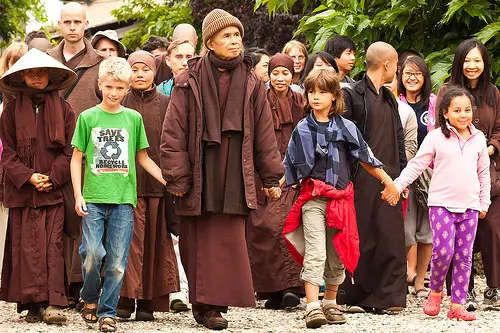The recent demise of famous Buddhist Monk Thich Nhat Hanh brought to mind some poignant memories. I met him, literally in passing, in 1997 as a doctoral student while doing a dissertation on his conception of ‘emptiness’ (sunya). I had traveled to a small college in northern New Jersey where he was delivering a speech, along with a number of devotees with whom I had corresponded about his philosophy, and they led me to a waiting-room room just as he was about to walk out to speak. The room was crowded and one of the monks mentioned to him that there was a graduate student present who would like to become more familiar with his ideas. He looked in our direction while moving past and smiled, saying “There’s nothing to it, just follow the path.”
This was sound advice from a devotee who followed the Buddhist path so resolutely and authentically that he blazed a new trail with it. Thich Nhat Hanh was born in central Vietnam during the early 1930’s. After a happy childhood in which he decided to become a Buddhist monk, he entered Tu’ Hieu Monastery at age seventeen. He received full ordination at Bao Quoc Institute in 1949. During the 1950’s he established several new monasteries in southern Vietnam, began publication of the journal “Vietnamese Buddhism”, and began formulating his project for “engaged Buddhism”. He eventually studied comparative religion and philosophy at Princeton and Columbia Universities but left to found the Vietnamese School of Youth for Social Service in 1964. During the war years in Vietnam he founded the Order of Interbeing, led the Buddhist Delegation to the Paris Peace Conference in 1969, survived several assassination attempts, and met with numerous political figures, policy makers and thinkers (including Robert McNamara, Robert Kennedy, Pope John Paul, Thomas Merton, and Martin Luther King –who subsequently nominated Thich Nhat Hanh for the Nobel Peace Prize in 1967). Exiled from Vietnam following the war, he established a sangha, Plum Village, as a monastery, spiritual retreat, and center for peace studies—from which he directed speaking tours, global social activism, and wrote a number of best-selling books.
After hearing and reading much more from Thich Nhat Hanh over the years after my initial encounter, his candid words have resonated with me on many levels and, even at that time, they provided the key to answering an essential question on which my research was focused: “How is it possible to recognize, as every Buddhist Monk must, the inherent emptiness of existence, and yet remain as engaged with life, ethics, and a commitment to global peace and justice as he did?” A common basic metaphysical tenet of all Buddhist schools of thought—particularly the Mahayana tradition that he followed—is that reality is ultimately subject to “dependent origination” or ‘emptiness’ (akin, by analogy, to “relational” theories of quantum physics) which holds that every existing entity or idea can only be understood in relation to all the other things, circumstances, and processes that make it what it is. In a world of unrelenting change, nothing is permanent and everything in life that appears to be enduring or certain is an illusion. The world is too expansive, infinite and multifarious, to ever capture through our limited and biased perceptions of it. Our desires and ideals, our achievements, even our relationships and loves, are all just abstract psychological constructs, designed by our minds to create an illusionary sense that we can possess something that persists in the perpetual flux of reality….but this illusion is ‘a futile passion’ (as J. P. Sartre called it), a vain conceit that leads us to worldly attachment and inevitable disappointment…In life, as Ecclesiastes tells us, “All is vanity and striving after the wind”
Indeed, the very reason that monks “take refuge” in an Order (or sangha) is that after realizing this inescapable truth, they retire from the world of desires and conceptual constructs to lead a life of “nonattachment” and inner stillness. Through this path of nonattachment, a person may come to see through the veil of misperception that causes us to think that all the things we value and invest our sense of purpose in (our money, possessions, accomplishments, desires, and egos) are not only real but important. By eliminating this misperception, we recognize how our attachments are not only futile, but are precisely what cause our angst, heartache and suffering. With this recognition it is hoped that, one-by-one (or perhaps all-at-once, in a sudden epiphany), these attachments effortlessly fade away, like a bad-dream at daybreak, and we awaken to the recognition of ultimate emptiness, which is the still peaceful clarity that allows the world’s beauty and meaning to finally emerge in our lives. Such is the essence of “tathata”, enlightenment or Nirvana.
It was this very fact about the nature and purpose of Thich Nhat Hanh’s Buddhist path that I couldn’t understand at the time. The quietude and cloistered life of a monk is meant to attain enlightenment by retiring from life’s goals and struggles. Yet Thich Nhat Hanh’s path was spent doing precisely the opposite. How, I wondered, could he have sought the still peace of tathata through the very mind-set that thwarts its attainment? Isn’t the commitment to any path in life an attachment that prevents us from realizing enlightenment? –Even Thich Nhat Ha himself said paradoxically “Do not be … bound to any doctrine theory, or ideology, even Buddhist ones.”
The key to this dilemma, he realized however, lies in the nature of an enlightened spirit, which is not simply focused on overcoming life’s attachments. The obsessive quest to overcome life’s attachments and illusions can also become an attachment and illusion itself. In actuality, the peace attained via a still, enlightened mind allows us to not just eliminate attachment to desires, but also attachment to all attachments –including, paradoxically, the attachment to nonattachment. In this spirit, worldly things and goals are gifts to be appreciated rather than necessities that must be satisfied. The enlightened soul remains mindfully attentive to, but free from bondage to, life’s desires, goals, and precious possessions. Instead, we recognize that the “dependent origination” of all things, and their consequent emptiness as enduring realities, frees us from being enthralled to their allure and allows us to live peacefully with them. “All things”, he writes,
“arise because their interdependence, and that is why nothing has an independent, separate identity. It is only because of our ignorance of this that we accuse, reprimand or slander one another. …When we see this, we have compassion for everyone…We are responsible, directly and indirectly, for each person’s consciousness…we won’t feel anger or blame. On the contrary, we will want to help him be free…”
Thich Nhat Hanh’s life-example illustrates how, ultimately, enlightenment is attained not by escaping from our life’s desires, possessions, and goals, but instead by experiencing them in a more authentic way. There is a Zen Buddhist koan that says “Before I was enlightened mountains were just mountains and rivers were just rivers. While becoming enlightened mountains were no longer mountains and rivers were no longer rivers. After being enlightened mountains are again mountains and rivers are again rivers”. Understood as opportunities for attaining inner peace rather than as attachments that our happiness is dependent upon, noble goals, achievements and objects of affection, continue the very path to enlightenment (a continuous path, which we travel even after it has been attained) that we first followed by renouncing these very attachments. Sallie B. King, an important source of scholarship on the “engaged Buddhism” movement that Thich Nhat Hanh, originated, concluded that “Nhat Hanh’s work breaks new ground for Buddhist thought and action. He has modernized Buddhism…He has significantly contributed to the forging of a way to bring Buddhism out of monastic seclusion and engage with all aspects of ordinairy life…as well as the major world issues of war, peace , spirituality, human community and human well-being”
Thus the enlightened mind allows us to return to our desires and goals in a new way. Thich Nhat Hanh realized this and lived a life of purposeful enlightenment in a way that made the world an immeasurably better place. This, as I heard him say long ago, is surely a worthy path to follow.
We hope you enjoy our articles. Please note, we may collect a share of sales or other compensation from the links on this page. Thank you if you use our links, we really appreciate it!



